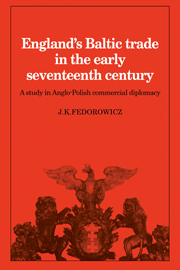 England's Baltic Trade in the Early Seventeenth Century
England's Baltic Trade in the Early Seventeenth Century Published online by Cambridge University Press: 05 November 2011
The significance of England's Polish trade
The substance of England's commercial relationship with Poland is well enough known not to need any elaboration here: in the most general terms it consisted of an exchange of finished English cloths (broadcloth, kersies and some ‘new draperies’) for traditional Polish raw materials, and commodities such as grain, timber, flax, hemp, pitch, tar, ashes, wax and iron. Setting aside for the moment a detailed consideration of the mechanics of this exchange, one should attempt at least a general assessment of its significance and mutual advantages for the two partners.
English broadcloth, known in Polish as lunński and later as falendysz cloth, was extremely popular among the gentry, rich merchants and professional class of Poland from the fifteenth century; only minor and declining competition from the most luxurious grades of Flemish, French or Italian cloth threatened its pre-eminence. Even the cheaper kersies were in considerable demand, though they faced increasing competition from comparable Dutch and Silesian products. Polish demand for English cloth even rose during the sixteenth century as Poland's booming exports earned increasing amounts of foreign specie. Nevertheless, English cloth, which constituted approximately 90 per cent of the value of all English exports to Poland, was never more than a luxury trade, satisfying the demands of fashion for only a small part of the Polish population. It was a trade which could easily be dispensed with in a crisis, particularly since alternative suppliers existed not only in Moravia, Silesia and Holland, but also within Poland itself: both Danzig and Wielkopolska produced significant amounts of lower priced cloth.
To save this book to your Kindle, first ensure [email protected] is added to your Approved Personal Document E-mail List under your Personal Document Settings on the Manage Your Content and Devices page of your Amazon account. Then enter the ‘name’ part of your Kindle email address below. Find out more about saving to your Kindle.
Note you can select to save to either the @free.kindle.com or @kindle.com variations. ‘@free.kindle.com’ emails are free but can only be saved to your device when it is connected to wi-fi. ‘@kindle.com’ emails can be delivered even when you are not connected to wi-fi, but note that service fees apply.
Find out more about the Kindle Personal Document Service.
To save content items to your account, please confirm that you agree to abide by our usage policies. If this is the first time you use this feature, you will be asked to authorise Cambridge Core to connect with your account. Find out more about saving content to Dropbox.
To save content items to your account, please confirm that you agree to abide by our usage policies. If this is the first time you use this feature, you will be asked to authorise Cambridge Core to connect with your account. Find out more about saving content to Google Drive.